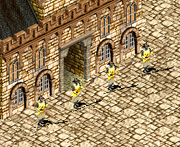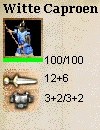

A Group of Witte Caproen
The Witte Caproen is the upgrade of the Scaerwetter. This unit is slightly stronger and more durable than its predecessor, but also carries fairly improved attack bonuses. However, this polearm infantry also does not benefit from a long pike.
Unit Statistics[]
Vital[]
Type: Pikeman
Available to: Flanders
Trained at: Guild Hall
Century: 15th
Requires: Castle

Combat[]
HP: 90
Attack: 12
Armor/Pierce Armor: 3/3
Special: +10 vs. archers, +6 vs. cavalry, +4 vs. ships and lancers.
Upgrades[]
Upgrade of: Scaerwetter
Attack: Forging, Iron Casting, Blast Furnace
Attack, hit points: Close Order Drill
Armour: Scale Armour. Mail Armour, Plate Armour
Speed: Squires
LOS: Pathfinding
Training time: Indenture, Nationalism (Flemish Unique Technology)
Commentary/Strategy[]
The Witte Caproen is essentially a heavy infantry unit - definitely the strongest unit Flanders has to offer. Flemish cost bonuses on infantry combined with their unique technology, which speeds up Guild Hall production, allow these units to be produced very quickly.
These should however be used as militia, not pikemen. Their anticavalry bonus is small, therefore they do practically nothing extra to Ruiters or Rhenish Knights, but can be of very good use against Bohemian War Wagons. (They dispose of mounted archers even faster, but are lacking in speed to do so.)
Witte Caproenen are comparable to the Halberd Militia (with a bonus against archers rather than infantry) and thus, although they have a decent base-attack and can overall replace Foot Knights, standard pikemen should always remain an integral part of your army.
Historical Background[]
From troops fighting purely for urban interests the Flemish infantry gradually changed to favour a more national sentiment. The Witte Caproenen (= "White Caps") formed the core of the militia of Ghent, and were named after the distinctive white hats they wore. They served both to maintain order inside the city and protect the city's interests in the wider area. In the great revolt of Ghent in the 1380's they played a pivotal part in propping up Artevelde's reign and helped defeat the people of Bruges. After Ghent's defeat at Gavere in 1453 the Witte Caproenen were abolished by Philip the Good. Distinctive caps were, incidentally, not unique to Ghent. Bruges had the Red Caps and Ypres had the Blue Caps.